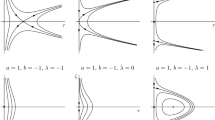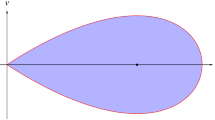Abstract
We discuss various definitions of equivalence for bifurcations of vector fields on the sphere and give a large number of examples (both known and new) that illustrate the advantages and disadvantages of different definitions. In addition to the classical definitions of strong and weak equivalence, we consider new notions of Sing-equivalence and moderate equivalence. These definitions seem to be more relevant to and consistent with the intuitive notion of equivalent bifurcations. They were introduced and used to describe the structural instability of some finite-parameter families of vector fields on the sphere and to study invariants of their classification.









Similar content being viewed by others
Notes
B. L. Shleifman, “Topology of deformations of complex parabolic germs” (in preparation).
References
A. A. Andronov and E. A. Leontovich, “Generation of limit cycles from a separatrix forming a loop and from the separatrix of an equilibrium state of saddle–node type,” Am. Math. Soc. Transl., Ser. 2, 33, 189–231 (1963) [transl. from Mat. Sb. 48 (3), 335–376 (1959)].
A. A. Andronov, E. A. Leontovich, I. I. Gordon, and A. G. Maier, Qualitative Theory of Second-Order Dynamic Systems (Nauka, Moscow, 1966; J. Wiley & Sons, New York, 1973).
V. I. Arnold, Additional Chapters of the Theory of Ordinary Differential Equations (Nauka, Moscow, 1978). Engl. transl.: Geometrical Methods in the Theory of Ordinary Differential Equations (Springer, New York, 1983), Grundl. Math. Wiss. 250.
V. I. Arnol’d, V. S. Afraimovich, Yu. S. Il’yashenko, and L. P. Shil’nikov, “Bifurcation theory,” Itogi Nauki Tekh., Ser.: Sovrem. Probl. Mat., Fundam. Napravl. 5, 5–218 (1986). Engl. transl. in Dynamical Systems V: Bifurcation Theory and Catastrophe Theory (Springer, Berlin, 1994), Encycl. Math. Sci. 5, pp. 1–205.
C. Camacho, “On the local structure of conformal mappings and holomorphic vector fields in \(\mathbf C^2\),” in Journées singulières de Dijon, 12–16 juin 1978 (Soc. Math. France, Paris, 1978), Astérisque 59–60, pp. 83–94.
A. V. Dukov, “Bifurcations of the ‘heart’ polycycle in generic 2-parameter families,” Trans. Moscow Math. Soc. 2018, 209–229 (2018) [transl. from Tr. Mosk. Mat. Obshch. 79 (2), 247–269 (2018)].
F. Dumortier, J. Llibre, and J. C. Artés, Qualitative Theory of Planar Differential Systems (Springer, Berlin, 2006), Universitext.
J. Ecalle, Les fonctions résurgentes, Vol. 1: Les algèbres de fonctions résurgentes (Univ. Paris-Sud, Dép. Math., Orsay, 1981), Publ. Math. Orsay 81-05.
R. M. Fedorov, “Upper bounds for the number of orbital topological types of planar polynomial vector fields ‘modulo limit cycles’,” Proc. Steklov Inst. Math. 254, 238–254 (2006) [transl. from Tr. Mat. Inst. Steklova 254, 254–271 (2006)].
N. Goncharuk and Yu. Ilyashenko, “Large bifurcation supports,”arXiv: 1804.04596 [math.DS].
N. Goncharuk, Yu. Ilyashenko, and N. Solodovnikov, “Global bifurcations in generic one-parameter families with a parabolic cycle on \(S^2\),” Moscow Math. J. 19 (4), 709–737 (2019); arXiv: 1707.09779 [math.DS].
N. Goncharuk and Yu. Kudryashov, “Bifurcations of the polycycle ‘tears of the heart’: Multiple numerical invariants,” Moscow Math. J. 20 (2), 323–341 (2020); arXiv: 1808.07459 [math.DS].
N. Goncharuk and Yu. G. Kudryashov, “Families of vector fields with many numerical invariants,”arXiv: 2003.01269 [math.DS].
N. Goncharuk, Yu. G. Kudryashov, and N. Solodovnikov, “New structurally unstable families of planar vector fields,” Nonlinearity (in press); arXiv: 1908.02693 [math.DS].
Y. Ilyashenko, “Towards the general theory of global planar bifurcations,” in Mathematical Sciences with Multidisciplinary Applications: In honor of Prof. C. Rousseau. And in Recognition of the Mathematics for Planet Earth Initiative, Ed. by B. Toni (Springer, Cham, 2016), Springer Proc. Math. Stat. 157, pp. 269–299.
Yu. Ilyashenko, Yu. Kudryashov, and I. Schurov, “Global bifurcations in the two-sphere: A new perspective,” Invent. Math. 213 (2), 461–506 (2018).
Yu. Ilyashenko and N. Solodovnikov, “Global bifurcations in generic one-parameter families with a separatrix loop on \(S^2\),” Moscow Math. J. 18 (1), 93–115 (2018).
A. Kotova and V. Stanzo, “On few-parameter generic families of vector fields on the two-dimensional sphere,” in Concerning the Hilbert 16th Problem (Am. Math. Soc., Providence, RI, 1995), AMS Transl., Ser. 2, 165, pp. 155–201.
I. P. Malta and J. Palis, “Families of vector fields with finite modulus of stability,” in Dynamical Systems and Turbulence: Warwick 1980 (Springer, Berlin, 1981), Lect. Notes Math. 898, pp. 212–229.
S. Newhouse, J. Palis, and F. Takens, “Bifurcations and stability of families of diffeomorphisms,” Publ. Math., Inst. Hautes Étud. Sci. 57, 5–71 (1983).
V. Sh. Roitenberg, “Nonlocal two-parameter bifurcations of vector fields on surfaces,” Cand. Sci. (Phys.–Math.) Dissertation (Yaroslav. Gos. Tekh. Univ., Yaroslavl, 2000).
R. Roussarie, “On the number of limit cycles which appear by perturbation of separatrix loop of planar vector fields,” Bol. Soc. Bras. Mat. 17 (1), 67–101 (1986).
R. Roussarie, “Weak and continuous equivalences for families of line diffeomorphisms,” in Dynamical Systems and Bifurcation Theory: Proc. Meet., Rio de Janeiro, 1985 (Longman Sci. Tech., Harlow, 1987), Pitman Res. Notes Math. Ser. 160, pp. 377–385.
A. A. Shcherbakov, “Topological classification of germs of conformal mappings with identical linear part,” Moscow Univ. Math. Bull. 37 (3), 60–65 (1982) [transl. from Vestn. Mosk. Univ., Ser. 1: Mat., Mekh., No. 3, 52–57 (1982)].
V. Starichkova, “Global bifurcations in generic one-parameter families on \(\mathbb S^2\),” Regul. Chaotic Dyn. 23 (6), 767–784 (2018).
F. Takens, “Normal forms for certain singularities of vector fields,” Ann. Inst. Fourier 23 (2), 163–195 (1973).
S. M. Voronin, “Analytic classification of germs of conformal mappings \((\mathbf C,0)\to (\mathbf C,0)\) with identity linear part,” Funct. Anal. Appl. 15 (1), 1–13 (1981) [transl. from Funkts. Anal. Prilozh. 15 (1), 1–17 (1981)].
Funding
This work was supported by the HSE Laboratory of Dynamical Systems and Applications (under grant 075-15-2019-1931 of the Ministry of Science and Higher Education of the Russian Federation) and by the Russian Foundation for Basic Research (project no. 20-01-00420).
Author information
Authors and Affiliations
Corresponding author
Rights and permissions
About this article
Cite this article
Goncharuk, N.B., Ilyashenko, Y.S. Various Equivalence Relations in Global Bifurcation Theory. Proc. Steklov Inst. Math. 310, 78–97 (2020). https://doi.org/10.1134/S0081543820050065
Received:
Revised:
Accepted:
Published:
Issue Date:
DOI: https://doi.org/10.1134/S0081543820050065




